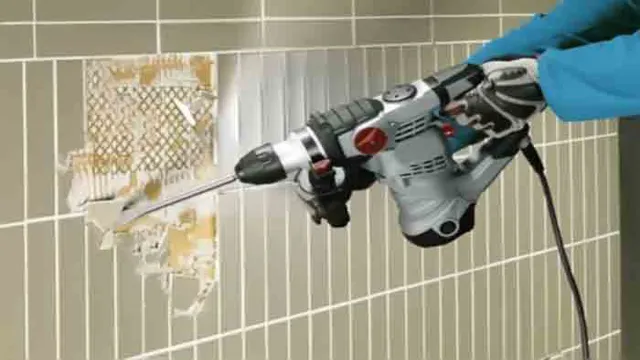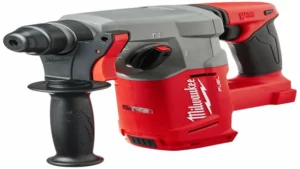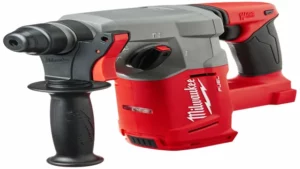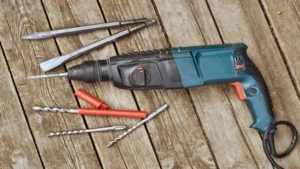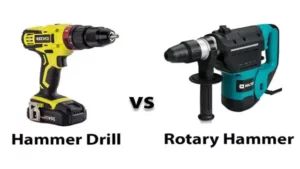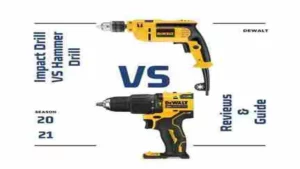If you’re planning on tackling a large-scale DIY project that involves heavy-duty drilling, then a rotary hammer might just be the tool you need to get the job done. But with its unique mechanism and varying settings, using a rotary hammer can be a daunting task for beginners. Fear not, because in this blog post, we’ll guide you through the steps on how to use a rotary hammer effectively and safely.
We’ll break down the parts of a rotary hammer, how to select the right drill bit, and provide tips on how to make the most out of this powerful tool. So let’s get started and transform your drilling game!
Introduction
If you’re a DIY enthusiast or a professional contractor, you’ve likely used a drill at some point. But what if you encounter a task that requires more power than a standard drill can provide? This is where a rotary hammer can save the day. A rotary hammer is a powerful tool that can drill, chisel and break through concrete, bricks and other tough materials.
If you’re wondering how to use a rotary hammer, it’s important to first read the manufacturer’s instructions. Before using the tool, make sure to equip yourself with the proper safety gear, such as safety glasses and gloves. Always make sure the tool is unplugged when inserting or removing bits.
Additionally, you should select the appropriate drill bit for the task at hand and adjust the drilling depth to prevent drilling too deep. Finally, always operate the rotary hammer with both hands, firmly positioning the tool against the surface you’re working on and keep a good balance. With a little bit of practice, you’ll be drilling through concrete walls like a pro in no time!
What is a Rotary Hammer?
A rotary hammer is a versatile and powerful tool that is used for heavy-duty drilling tasks. It is a type of hammer drill that uses a rotary mechanism to drive a piston forward, providing strong and rapid impacts required to bore through hard surfaces like concrete, brick, or stone. The rotary hammer is popularly used in construction, renovation, and demolition work, where it can make quick work of drilling and chiseling.
Homeowners may also use rotary hammers for DIY projects like installing new door frames, creating new electrical outlets, or building a deck. With its powerful motor and superior technology, a rotary hammer is an essential tool for anyone who wants to get their drilling tasks done easily and efficiently.
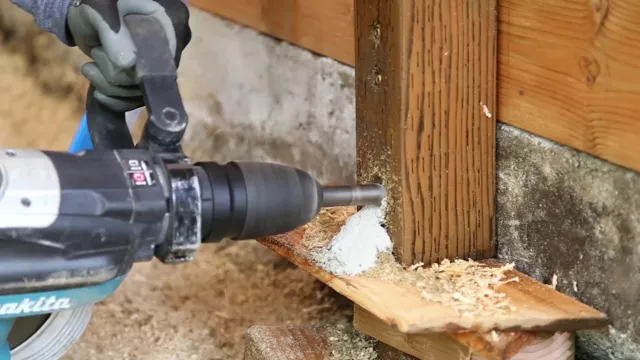
When to Use a Rotary Hammer?
Rotary hammer Rotary hammers are powerful tools that are designed for heavy-duty drilling and demolition work. They are commonly used in construction, woodworking, plumbing, and other similar industries. If you are working on a project that involves drilling through tough materials like concrete, brick, or stone, then a rotary hammer is the right tool for the job.
These tools deliver more power and speed than a standard drill, making them ideal for demanding applications. Additionally, rotary hammers are also useful for chiseling or breaking up concrete or masonry, making them a versatile tool for any construction site. So, if you want to get the job done faster and more efficiently, a rotary hammer is the way to go.
Preparation
If you want to start using a rotary hammer at your construction site or DIY project, make sure you have everything prepared. Firstly, you need to read the manufacturer’s instructions and safety guidelines before using the tool. Then, you should wear protective gear, including gloves, eye goggles, and respiratory masks to protect yourself from the debris and dust flying around during drilling.
Next, you should select the right drill bit depending on the material you are working on and the type of hole you want to create. Make sure to insert the bit correctly into the tool and secure it in place tightly. Also, check the hammer’s settings to make sure it is set to the correct mode for the task you want to perform.
By taking the time to prepare and ensure everything is set up correctly, you can use a rotary hammer safely and effectively on your project.
Safety Gear
When it comes to safety gear, preparation is key. It’s important to have the right equipment and to know how to use it properly before you start any potentially dangerous activity. This includes things like helmets, gloves, eye protection, and more specialized gear like climbing harnesses and safety harnesses.
Not only should you have the right gear, but you should also inspect it regularly to ensure that it’s in good working condition. A helmet that’s been damaged in a previous fall, for example, might not offer the same level of protection in a future accident. So take the time to check your equipment regularly and replace anything that’s damaged or worn out.
By being prepared with the right safety gear, you’ll be able to enjoy your activities with confidence and peace of mind.
Power Source
When it comes to preparing your power source, there are a few key steps you should take to ensure everything runs smoothly. First, make sure you have the right equipment and that it’s in good condition. Whether you’re using a generator or solar panels, you’ll want to do a thorough check before setting up.
Next, consider your location and the weather conditions you might face. Will you need extra fuel or supplies? Do you need to set up some kind of shelter or protection from the elements? Finally, make sure you have a plan in place for how to use your power source responsibly. Depending on your needs, you may need to prioritize certain appliances or devices, and you’ll want to make sure you’re not using more energy than you need.
With proper preparation, your power source can be a reliable and effective tool for staying connected, even off the grid.
Bit Selection
Bit selection is a crucial step in programming as it affects the efficiency of the code. Choosing the right bit is essential to decrease the time and resources needed to execute the program. The first step to proper bit selection is to identify the type of data that will be processed.
It’s also important to consider the size of the data and how much memory it will require. The size and type of data will determine the appropriate bit to use to reduce memory usage and optimize the program’s speed. Moreover, the nature of the operation performed should be considered when selecting a bit.
Some operations are more efficient with certain bits than others. To ensure that the program runs smoothly, it’s important to research the different types of bits available and their uses. By selecting the appropriate bit, one can maximize the performance of the program, reducing the occurrence of errors and improving its functionality.
Using the Rotary Hammer
If you’re looking to make holes or chisel into hard materials like concrete or masonry, a rotary hammer is the perfect tool for you. But before you start drilling away, it’s important to know how to use a rotary hammer properly. Firstly, make sure you have the right drill bit for the job, as different materials require different types of bits.
Secondly, select the correct setting for the job – rotary hammers come with different modes like hammer-only for chiseling or rotation and hammer for drilling. Thirdly, be sure to hold the tool firmly with both hands, positioning it perpendicular to the surface. To prevent fatigue, let the rotary hammer do the work and simply guide it.
Lastly, don’t forget to wear protective gear like safety glasses and ear protection as rotary hammers can be loud and may produce dust. With these tips, you can safely and effectively use a rotary hammer for your DIY projects.
Positioning
When it comes to using a rotary hammer, one of the most important things to consider is your positioning. This means not only your physical position in relation to the surface you’re working on, but also the angle at which you’re holding the tool. Generally, you want to be standing directly in front of the surface you’re working on, with the tool held at a straight angle.
This will allow the chisel or bit to make even contact with the surface, which is crucial for efficient and effective drilling. Additionally, it’s important to maintain a steady grip on the tool while using it, and to avoid making jerky or erratic movements. With the right positioning and technique, a rotary hammer can be an incredibly powerful and versatile tool for drilling and chiseling through even the toughest materials.
So next time you’re working with a rotary hammer, take a moment to consider your positioning and make any necessary adjustments for the most precise and efficient drilling possible.
Firm Grip
If you want to make sure you have a firm grip when using a rotary hammer, there are a few things you can do. First and foremost, make sure you’re wearing gloves to help you maintain a good grip on the tool. Additionally, using both hands to grip the hammer can help you keep a steady hold.
It’s also important to make sure you’ve adjusted the depth gauge correctly so that the bit isn’t able to slip or move around as you’re working. And finally, make sure you’re using the right size and type of bit for the job you’re doing – using the wrong bit can lead to difficulty controlling the tool, which could result in injury or damage to your workpiece. By being mindful of these tips, you’ll be able to keep a firm grip and work with your rotary hammer safely and effectively.
Starting the Hammering Process
When it comes to starting the hammering process, using a rotary hammer can be a game-changer. Unlike traditional hammers, the rotary hammer uses a piston to create a powerful, pneumatic force that can easily break through tough surfaces like concrete and stone. This tool provides a faster and more efficient way to hammer on a variety of surfaces, making it essential for both commercial and DIY projects.
The rotary hammer is easy to use and provides more safety and control than traditional hammers since it minimizes the likelihood of slippage and missed strikes. It’s also designed to reduce vibration and noise, making it an excellent choice for working in indoor settings where noise levels must be kept to a minimum. Overall, the rotary hammer is an indispensable tool for any project that involves heavy-duty hammering, making it a keyword to remember for anyone seeking to get the job done quickly and efficiently.
Adjusting Speed and Power
When using a rotary hammer, it’s important to adjust both the speed and power to efficiently and effectively tackle your project. Start by adjusting the speed of the hammer based on the type of material you’ll be drilling into. For softer materials, a lower speed can be used, while harder materials require a higher speed.
This will help prevent overheating and allow you to control the drilling more easily. When it comes to the power, start with a lower setting and gradually increase as needed. Too much power can cause damage to the material or the tool itself.
By finding the right balance of speed and power, you can ensure the rotary hammer is working efficiently and that your project is executed properly. Remember to always wear proper safety gear when operating any power tool.
Maintenance
If you’re new to using a rotary hammer, it’s important to understand how to maintain it properly. First, it’s essential to keep the tool clean and lubricated to prevent rust and maintain smooth operation. You can use a soft bristle brush to clean out any debris or dust, and a silicon lubricant to prevent the gears from seizing up.
It’s also necessary to check and replace the carbon brushes frequently to ensure proper electrical contact. Another important maintenance step is to check the chuck regularly and make sure it’s tightened securely to prevent slippage. And lastly, it’s essential to store your rotary hammer in a dry and cool area to prevent it from becoming damaged.
By regularly maintaining your rotary hammer, you can prolong its lifespan and ensure it continues to work effectively. So follow these simple steps and enjoy efficient and high-quality performance from your rotary hammer.
Cleaning and Lubricating
Cleaning and lubricating your machinery is a crucial aspect of maintenance that can significantly extend the life of your equipment. Regular cleaning helps to remove dirt, dust, and debris that inevitably accumulates over time, which can cause significant damage to your machinery’s components. Lubrication helps to reduce friction between moving parts, preventing them from wearing out prematurely and reducing the chances of breakdowns.
Neglecting to clean and lubricate your machinery can lead to costly repairs and downtime, ultimately affecting your business’s bottom line. Therefore, it is essential to make sure cleaning and lubricating are part of your regular maintenance routine to keep your machinery running smoothly and efficiently. Remember, a little bit of maintenance can go a long way in preventing unexpected and costly breakdowns.
Storage
When it comes to storage, maintenance is key to ensuring your items stay in good condition. Proper storage maintenance involves consistent cleaning and ensuring the correct environment for your items. For example, if you have clothing in storage, it’s important to wash and air them out every so often to prevent mold growth.
Additionally, storing them in a cool, dry place away from direct sunlight can prevent fading and discoloration. For larger items such as furniture, regular dusting and polishing can keep them looking like new. Neglecting storage maintenance can lead to expensive and irreversible damage to your possessions.
So, take the time to properly care for your stored items, and they will last for years to come.
Conclusion
In conclusion, using a rotary hammer is like playing a game of whack-a-mole – but instead of pesky critters, you’re tackling tough concrete and masonry. You’ll need to arm yourself with the right safety gear, choose the appropriate bit for the job, and use the tool with precision and care. But when done right, a rotary hammer can make light work of even the most stubborn surfaces.
So go forth, dear DIYers, and hammer away with confidence and skill!”
FAQs
What is a rotary hammer used for?
A rotary hammer is a tool that is used for heavy-duty drilling and chiseling tasks. It is commonly used in construction and demolition work.
How does a rotary hammer work?
A rotary hammer works by delivering a powerful hammering action to the drill bit or chisel. This is achieved through the use of a piston that compresses air and then releases it in short bursts, creating a hammering effect.
What is the difference between a rotary hammer and a regular hammer drill?
While both tools can be used for drilling into concrete and other tough materials, a rotary hammer is generally more powerful and effective at chiseling and breaking up concrete. This is because it delivers a more intense hammering action.
What type of drill bit should I use with a rotary hammer?
You should use specific SDS (slotted drive system) drill bits that are designed to work with rotary hammers. These bits have a special grooved shank that allows them to lock into the chuck and rotate with the bit.
What safety precautions should I take when using a rotary hammer?
Always wear eye and ear protection when using a rotary hammer, as it produces a lot of noise and debris. Make sure the tool is securely locked into place before starting to use it, and always use both hands when operating it.
Can I use a rotary hammer for drilling into wood or metal?
Yes, a rotary hammer can be used for drilling into wood or metal, but it is not the most efficient tool for these tasks. It is best suited for heavy-duty drilling and chiseling into concrete, brick, or stone.
How do I choose the right rotary hammer for my needs?
When choosing a rotary hammer, consider factors such as the size and scope of your project, the materials you will be working with, and your budget. Look for a tool that is powerful enough to handle your tasks but also easy to maneuver and control.
